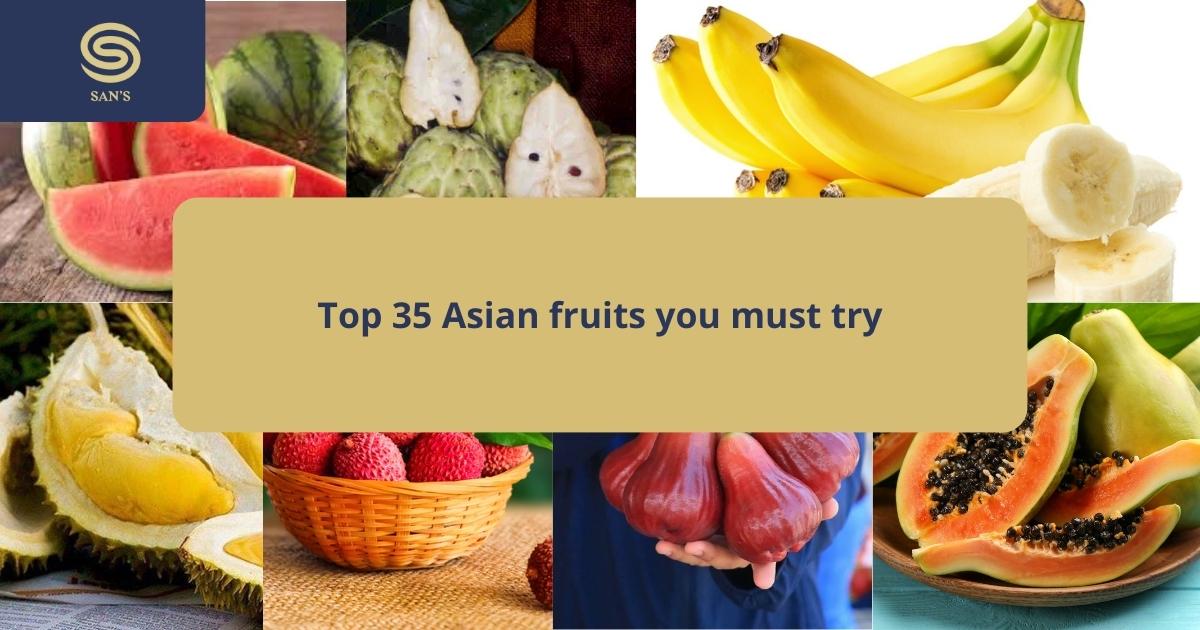From the sweet succulence of mangoes to the creamy richness of durians, Asian fruits provide a sensory experience like no other. Join Sanhotelseries to explore the list of Asian fruits suitable for landscapes and markets across the continent.
Asia is renowned for its incredible culinary diversity, and this extends to its rich variety of fruits. From sweet and tropical to tangy and exotic, Asian fruits offer an exciting mix of flavors and textures that are bound to captivate the senses.
1. Top 10 Green Asian Fruits
1.1. Jackfruit
Jackfruit stands out with its unique shape, resembling a slightly elongated melon. Its vibrant green skin is covered with small, smooth bumps. With a texture similar to mango or pineapple, jackfruit’s flavor is often debated. Some enthusiasts describe it as a sweet blend of mango and pineapple, while others find its texture akin to pulled pork, thanks to its stringy fibers.

1.2. Guava
Those who love soft, sweet fruits will relish Vietnamese guava, a much-loved treasure among green Asian fruits. This palm-sized delight has edible skin and flesh, making it easy to enjoy straight from the hand. Depending on the variety, the flesh of guava can range in color from pink to red or orange, offering a juicy, pear-like sweetness with a strawberry-like flavor. Guava is a favorite in smoothies and fruit-based desserts.

1.3. Pomelo
As the largest member of the citrus family in Asia, pomelo boasts a bold appearance with its round shape and vibrant green or yellow skin dotted with marks. Inside, the thick, creamy flesh ranges in color from white to pink or purple, depending on the variety, with few seeds. Pomelo has a milder, sweeter taste compared to grapefruit, making it a versatile ingredient in salads, juices, and sauces.

1.4. Durian
Prepare to be either enchanted or repelled by durian. Its thorny, spiked shell houses a creamy flesh with a sweet taste that sparks strong opinions. Its notorious odor has made it controversial, even banned in some places for its overpowering smell. Despite this, durian is loved in many Asian dishes, from ice cream to curries, appealing to adventurous palates.

1.5. Avocado
Vietnamese avocados are renowned for their creamy texture and rich flavor, enhancing various dishes with their nutritional value. Whether blended into smoothies or incorporated into salads, avocados are a prized ingredient. Grown primarily in the Central Highlands, Vietnamese avocados thrive in the fertile soil and are at their peak in summer.

1.6. Soursop
Soursop, a hidden gem among Asian fruits, has an oval shape and a bold, complex flavor that appeals to many across Asia and the Caribbean. Underneath its spiked green skin lies aromatic, creamy flesh. Its taste is a balance of strawberry sweetness with apple tartness and a hint of citrus sourness. Soursop is often eaten raw but is also enjoyed in smoothies and desserts.

1.7. Custard Apple
Vietnam is home to two varieties of custard apples, both offering a unique taste and texture. With a rough green peel, custard apple encases milky white pulp that is sweet and pleasant. While the skin and seeds are inedible, the fruit’s flesh can be easily scooped or broken open by hand, making it a perfect tropical treat.

1.8. Coconut
Coconut is one of the most iconic tropical fruits in Asia, widely used in cooking, beverages, and desserts. Available in both green and brown varieties, green coconuts are prized for their refreshing water, while brown coconuts offer rich, creamy flesh. Whether sipping on coconut water or enjoying the creamy texture of the flesh, fresh coconut is a must-try in Asia.

1.9. Star Apple
True to its name, star apple reveals a star-shaped pattern when sliced, adding a whimsical touch to its appearance. Available in purple, brown, or yellow varieties, star apple delivers a unique flavor that combines the sweetness of grapes with the earthiness of persimmons. It’s a delightful addition to fruit platters and desserts.

1.10. Watermelon
Watermelon, while familiar worldwide, remains a beloved fruit throughout Asia. Available in green, orange, yellow, or white varieties, it offers a refreshing burst of sweetness, making it perfect for summer. Whether enjoyed as-is or in juices, salads, or desserts, watermelon is a tropical staple.

2. The 5 Most Popular Red Asian Fruits
2.1. Lychee
With its bumpy pink-red skin, lychee hides juicy, sweet, and slightly tart white flesh. Its flavor, with hints of citrus and rose, makes it a popular fruit across Asia. Lychees are featured in juices, smoothies, jams, and desserts like lychee jelly or mojitos, adding a refreshing sweetness to various dishes.

2.2. Rambutan
Rambutan is named for its hairy red rind, which encloses a creamy white flesh inside. The fruit’s sweet and sour flavor, akin to grapes, makes it a favorite among many. Its compact size and ease of peeling make it a convenient and tasty snack.

2.3. Dragon Fruit
Dragon fruit is easily recognized by its bright pink-red skin and green-tipped spikes. Its taste is similar to a blend of pear and kiwi, offering a subtle sweetness. Despite its exotic appearance, dragon fruit is widely available in Asian markets and is commonly used in smoothies.

2.4. Tambis
Tambis, a common Southeast Asian fruit, has a round, reddish exterior and sweet, watery flesh. Its refreshing taste makes it a popular snack during hot days. Packed with vitamin C and fiber, tambis is a healthy and refreshing choice.

2.5. Chinese Bayberry
Chinese bayberry, also known as yangmei or waxberry, offers a flavor that combines the sweetness of strawberries with the tartness of cranberries. Widely enjoyed in juices, desserts, and traditional medicine, Chinese bayberry is a beloved red fruit in Asia.

3. What Are the Best Yellow Asian Fruits?
3.1. Banana
Bananas, while common worldwide, show incredible diversity across Asia. From the familiar Cavendish to the tiny bananas of the Philippines, each region has its unique take. Whether grilled, fried, or eaten fresh, bananas are a versatile and popular fruit.

3.2. Longan
Known as the “dragon’s eye” due to its appearance, longan has a sweet and sour flavor reminiscent of grapes but sweeter than lychee. It is popular in desserts like sorbets and has even found its way into savory dishes.

3.3. Pear
Asian pears, crisp and juicy, offer a balance between the textures of apples and pears. Popular in Japan and Korea, they are enjoyed fresh, pickled, or dried, adding a refreshing sweetness to many dishes.

3.4. Mango
Mangoes are a quintessential tropical fruit in Asia, celebrated for their juicy, sweet flavor. Vietnamese mangoes are known for their size and taste, making them a favorite in smoothies, salads, and even traditional Thai sticky rice dishes.

3.5. Papaya
Papayas boast a mildly sweet flavor with a buttery texture. Often likened to cantaloupe, papayas are enjoyed in juices, jams, and cocktails, with their seeds offering added nutritional benefits.

3.6. Starfruit
Starfruit is as visually striking as it is delicious. With a taste reminiscent of apples and pears, its yellow flesh offers a subtle sweetness, perfect for garnishing salads and desserts.

4. Top 3 Delicious Purple Asian Fruits
4.1. Mangosteen
Mangosteen, often referred to as the “queen of fruits,” is prized for its delicate, sweet flavor. Beneath its thick, purple rind lies juicy white flesh that resembles cloves. The taste is a delightful blend of peach and pineapple, making it a favorite in Southeast Asian countries like Vietnam, Thailand, and Indonesia. Mangosteen’s luscious flavor makes it a key ingredient in jams, desserts, and juices across the region.

4.2. Passion Fruit
Known for its bold flavor, passion fruit stands out among purple Asian fruits. Its tough exterior conceals soft, yellow, seed-filled pulp with a tangy taste. Passion fruit is enjoyed both raw for its sharp, acidic flavor or incorporated into a variety of dishes, from smoothies and juices to desserts like sorbets. Its combination of sweetness and tartness makes it a versatile and exciting fruit in Asian cuisine.

4.3. Grape
Grapes, especially the deep purple Kyoho variety, are a beloved fruit across Asia. These grapes are large, juicy, and have a high sugar content, providing a luscious sweetness with mild acidity. Kyoho grapes are commonly enjoyed fresh but are also used in jellies, jams, and even savory dishes. Their rich, juicy flavor makes them a popular choice in East Asia and beyond.

5. Orange Asian Fruits That You May Not Know
5.1. Mandarin Orange
Originating from China, mandarin oranges are petite and easy to peel, making them a convenient and delicious snack. Their sweet, citrusy flavor makes them a favorite across Asia. The zest is often used in marmalades, while the juicy segments add a bright flavor to salads and desserts.

5.2. Persimmon
Among the many varieties of persimmon, the Japanese persimmon is especially prized for its sweet, honey-like flavor. Resembling a tomato in appearance, it has a juicy, crisp flesh that can be eaten fresh or baked into warm, comforting desserts. Persimmons are also a popular ingredient in salads, where their sweetness pairs well with savory dishes.

5.3. Yuzu
Though originating in China, yuzu is widely embraced across Japan and other Asian countries. Its intensely sour, citrusy flavor resembles a combination of lemon and mandarin. While rarely eaten raw due to its strong taste, yuzu is commonly used in sauces, condiments, and even as a zest in sushi, adding a bright, tangy note to savory dishes.

6. Other Asian Fruits You Should Try
6.1. Sapote
Sapote, though native to Central America, has become a popular fruit in Asia. With its rough brown skin and sweet, salmon-colored flesh, it has a creamy texture similar to sweet potato or pumpkin. Sapote is often enjoyed raw but also used in curries and sauces, adding a rich sweetness to savory dishes.

6.2. Kiwi
Originally from China, kiwi has gained global popularity due to its bright green flesh and black seeds. Its sweet-tangy flavor is reminiscent of strawberries, and it’s often enjoyed raw. The skin, while edible, is often peeled before consumption, adding a refreshing touch to salads and smoothies.

6.3. Tamarind
Tamarind, a staple in Southeast Asian and Middle Eastern cuisines, is known for its tangy flavor. Its long, reddish-brown pods contain sour pulp that’s often used in sauces, chutneys, and dressings. The unique taste of tamarind adds a burst of flavor to curries and other dishes.

6.4. Langsat
Langsat, also called lanzones, is native to Malaysia and is cherished for its bittersweet flavor. With pale brown skin and juicy flesh, it resembles grapefruit but has a more delicate taste. Langsat is often eaten raw or turned into jams and syrups, making it a versatile addition to various desserts.

6.5. Wood Apple
Wood apple, with its hard, woody shell, offers a grainy, aromatic flesh inside. The fruit has a mild sweet-tangy taste, often used in chutneys and jams. Its interior may remind some of pulled pork, but its flavor is uniquely its own, used to enhance a variety of dishes in Indian cuisine.

6.6. Snake Fruit
Also known as salak, snake fruit is easily peeled despite its spiky, reddish-brown skin. The clove-like white or yellow pulp inside offers a honeyed sweetness with a hint of acidity. Resembling a mix of apple, banana, and pineapple, snake fruit adds a tropical flair to both traditional and modern dishes.

6.7. Pulasan
A relative of rambutan, pulasan is a small fruit with thick skin and blunt spikes. Once peeled, the fruit reveals sweet, creamy flesh with a flavor akin to grapes, but slightly sweeter. Pulasan is commonly used in smoothies and ice creams, offering a rich and unique taste.

6.8. Goji Berries
Goji berries have earned their reputation as a superfood across Asia due to their rich antioxidant content. These small red-orange berries have a flavor reminiscent of cranberries and sour cherries, with a chewy texture. They are often eaten as a snack or used as a topping for cereals, yogurts, and baked goods, adding both nutrition and flavor to any dish.

Conclusion
Asian fruits offer more than just a burst of flavor; they are a gateway to the rich cultural heritage and natural diversity of the continent. Whether you’re savoring the tropical sweetness of a mango or daring to try the bold flavors of durian, each fruit tells a story deeply rooted in the history and culinary traditions of Asia.
For travelers, experiencing these fruits firsthand—whether in bustling markets, along scenic landscapes, or as part of a gourmet meal—is a must. Vietnam, in particular, is home to a wide variety of these delicious fruits. When visiting popular travel destinations like Hanoi, Ho Chi Minh City, Phu Quoc, Nha Trang, Hoi An, or Ha Long, you will encounter an array of these delightful fruits that reflect the bounty and beauty of the region.
Here are the “Top 35 Delicious Asian Fruits you must try” Wishing you a delightful trip to Asian! If you visit Vietnam and the capital Hanoi, you can book a room at San Hotel for the best prices here!
Follow us on Facebook to update the latest travel information daily: San Hotel Series





